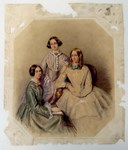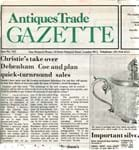At its peak in the ’80s and ’90s holding eight or more sales a week, Christie’s South Kensington was both a seemingly never-ending source of middle-range chattels and a kind of ‘R&D’ department for a range of collecting areas from posters to polyphons.
In that rose-tinted, pre-internet age, collecting had its posh London shop window.
That metaphorical and physical window was finally shuttered last week when – ahead of the real farewell at a local hotel – outgoing chairman Nic McElhatton brought down the gavel on the final lot sold at CSK (see report, page 22-23).
Of course, the shock to the system of any saleroom closure can be overstated.
The retreat of the major brands from the traditional middle-market heartland has provided the backdrop to the UK auction business for two decades or more.
Few will celebrate the demise of another of London’s middle-market salerooms, but ultimately neither the merchandise nor the expertise will be lost. Both will migrate elsewhere: to the major regional players or the growing number of London ‘indies’.
And yet in the days between the ‘end of an era’ announcement made in March and the final sale at ‘South Ken’ on July 19 a vacuum of sorts has started to form. After all, this was not just any saleroom closure. It was CSK: the last tangible link between the big brands and the grassroots of the antique trade.
Just how big that vacuum turns out to be will depend on how much business Christie’s will leave behind as its two UK selling spaces become one. Earlier in the summer, Christie’s UK chairman Orlando Rock told ATG his plans for King Street include a broader range of sales at a wider range of price levels with perhaps eight to 10 ‘live’ catalogues added to the calendar.
That’s perhaps 1500 of the 10,000-plus lots CSK offered last year. Scaling up the still-emerging online-only offering is the transition plan for some of the other 8500.
So far results across the platform have been mixed. Some vendors are yet to be convinced this is the road to strong prices in what will always be a ‘seeing and touching’ business. The small print of distance-selling rules is also problematic.
“This will be a marathon not a sprint – with business won in the time-honoured way through long-term client relationships
But sell-through rates of 81% across the first 35 sales of 2017 have left Christie’s global president Jussi Pylkkänen comfortable with the pace of progress. He told ATG: “In the 1970s, the best way of creating audience volume was with a saleroom like South Kensington. Now, with online searching, that is not the case.”
Jostling for position
There might be less meat left on the CSK carcass than some are hoping. Meanwhile, away from the digital revolution the sound of jostling for position is growing louder.
Chiswick Auctions, the west London general saleroom that has swept up several ex-Bonhams and Christie’s staff in recent years, has thus far made the biggest play for those 8500 lots.
Earlier this month it declared intentions to open a South Kensington showroom manned by eight former Christie’s staff. Nigel Shorthouse, former CSK business manager, is to lead the project. Details are yet to be disclosed as contracts are finalised, but Chiswick says it hopes to open at a site “within a stone’s throw” of CSK by September.
Roseberys too believes it can make ground. The south London firm has picked up specialists in jewellery and decorative arts plus former CSK chairman Nic McElhatton as a consultant (see page 18-19), while it can be no coincidence that Bonhams has chosen recent weeks to embark upon a blanket advertising campaign across the capital.
Black cabs with Bonhams logos rode up and down Old Brompton Street last Wednesday: surely the marketing equivalent of parking the tanks on the lawn.
But by no means everyone has declared their hand. Sotheby’s will wait for a respectful lapse before announcing it has taken on department specialists.
Woolley & Wallis and Lyon & Turnbull, two regional salerooms that already have a permanent London presence and experience at the higher echelons of the market, are also yet to break cover. There are potentially big deals still to be done.
This will be a marathon not a sprint – with business won in the time-honoured way through long-term client relationships – but, to a degree, time is of the essence.
Momentarily, there is an unprecedented availability of talent in the job market – seasoned specialists, business-getters, logistics and administration personnel. All have paid what McElhatton termed “the ultimate sacrifice” in the knowledge that “Christie’s always came first”.
Whatever does follow in its wake, it is unlikely to be quite like CSK. As McElhatton said in his closing speech: “The chemistry was unique, a recipe concocted from the ideal location, a brand created 251 years ago by James Christie, an era when the interest in the art and collectables market was beginning to explode and, lastly but by no means least, the people.” This was more than misty-eyed hyperbole.
At the heart of Christie’s success in South Kensington was high prices for vendors, achieved, more often than not in recent years, by harnessing the global brand that appeared above the door.
From Clarice Cliff to dolls and teddy bears, few of the markets it has chosen to drop along the way have thrived without it.
“There’s an assumption by other auctioneers that they can just step in to this niche,” says McElhatton. “The issue for smaller auctioneers will be, you’re not Christie’s so you won’t get the prices”.
Herein surely lies the biggest challenge.
Invention and reinvention was part of CSK’s success. It might take something equally ‘new’ to snare the next generation of clients.















